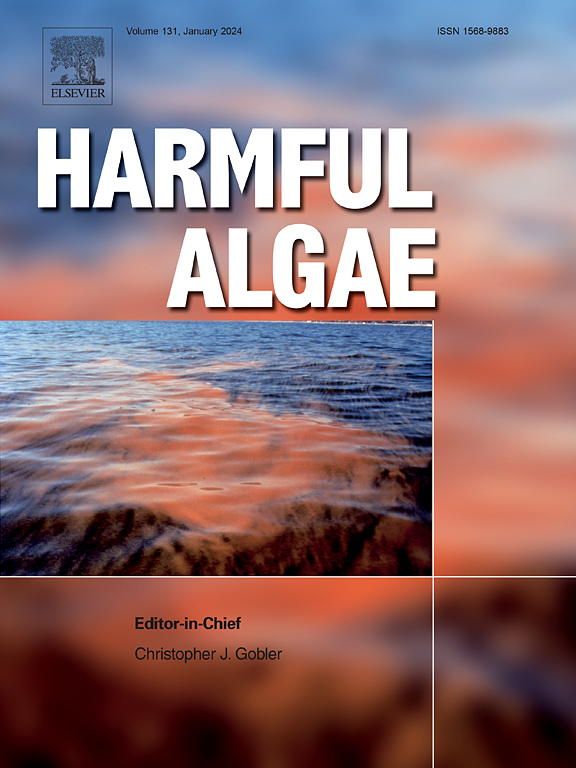桡足动物对两种恐龙细胞内和细胞外毒素的影响
IF 5.5
1区 生物学
Q1 MARINE & FRESHWATER BIOLOGY
引用次数: 0
摘要
桡足类动物可能通过选择性排斥有害细胞而促进有害藻华的形成。此外,桡足类和它们散发的化学线索桡足酰胺已被证明可以诱导麻痹和失忆毒素产生微藻增加毒素产生。然而,尚不清楚腹泻贝类毒素(DST)的生产者,如恐龙对桡足类或桡足类是否有类似的反应。在这里,我们将实验室培养的saculus和D. acuminata暴露在Acartia sp. copepodamides或copepodamides的直接放牧中,并在三天后测量它们的毒素。瓢虫产生的总毒素(DPTs),冈田酸、果皮毒素-2和冈田酸c9 -二醇酯在小囊瓢虫中增加了8 - 45%,但仅在最高(10 nM)的copepodamide处理下与对照有显著差异,而毒素含量在针叶瓢虫中没有受到影响。所有组的生长速率都很低,这解释了毒素含量变化的91%。在最高的copepodamide处理(5 - 10 nM)中,dpt从内部隔室重新分布到细胞外介质中,这是对照的两到三倍,表明毒素的主动释放或被动泄漏。对子宫内膜代谢组的非靶向分析表明,在最高剂量的copepodamide处理下,两种物种的代谢物谱发生了显著变化,与已知毒素无关。然而,尚不清楚这些是应激反应还是由更复杂的机制引起的。与先前报道的一些亚历山德里亚和伪尼奇亚相比,这里观察到的恐龙中相对较小的食草诱导效应表明,恐龙中DPT的产生可能不是由桡足类诱导的,除非在桡足类密度高的斑块中。因此,dpt可能代表了恐龙的组成化学防御,或者是完全不同的目的。本文章由计算机程序翻译,如有差异,请以英文原文为准。
Effects of copepod chemical cues on intra- and extracellular toxins in two species of Dinophysis
Copepods may contribute to harmful algal bloom formation by selectively rejecting harmful cells. Additionally, copepods and the chemical cues they exude, copepodamides, have been shown to induce increased toxin production in paralytic and amnesic toxin producing microalgae. However, it is unknown if diarrhetic shellfish toxin (DST) producers such as Dinophysis respond to copepods or copepodamides in a similar fashion. Here we expose laboratory cultures of Dinophysis sacculus and D. acuminata to direct grazing by Acartia sp. copepods or copepodamides and measure their toxins after three days. Total Dinophysis-produced toxins (DPTs), okadaic acid, pectenotoxin-2, and C9-diol ester of okadaic acid, increased by 8 - 45 % in D. sacculus but was significantly different from controls only in the highest (10 nM) copepodamide treatment whereas toxin content was not affected in D. acuminata. Growth rate was low across all groups and explained up to 91 % of the variation in toxin content. DPTs were redistributed from internal compartments to the extracellular medium in the highest copepodamide treatments (5 - 10 nM), which were two to three times higher than controls and indicates an active release or passive leakage of toxins. Untargeted analysis of endometabolomes indicated significant changes in metabolite profiles for both species in response to the highest copepodamide treatments, independent of known toxins. However, it is not clear whether these are stress responses or caused by more complex mechanisms. The relatively small grazer-induced effect in Dinophysis observed here, compared to several species of Alexandrium and Pseudo-nitzschia reported previously, suggests that DPT production in Dinophysis is likely not induced by copepods, except perhaps in patches with high copepod densities. Thus, DPTs may, represent either a constitutive chemical defence for Dinophysis, or serve an altogether different purpose.
求助全文
通过发布文献求助,成功后即可免费获取论文全文。
去求助
来源期刊

Harmful Algae
生物-海洋与淡水生物学
CiteScore
12.50
自引率
15.20%
发文量
122
审稿时长
7.5 months
期刊介绍:
This journal provides a forum to promote knowledge of harmful microalgae and macroalgae, including cyanobacteria, as well as monitoring, management and control of these organisms.
 求助内容:
求助内容: 应助结果提醒方式:
应助结果提醒方式:


